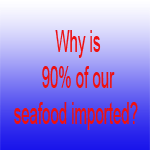

 |
 |
 On
January 7 of this year New Jersey Congressman Frank Pallone once again
introduced legislation “To prohibit the commercial harvesting of Atlantic
striped bass in the coastal waters and the exclusive economic zone.” The
Bill (HR 393) would make it “unlawful to engage in, or to attempt to engage
in” such harvesting. Assuming that he is representing far more seafood
consumers than sportsfishermen and women, we are sure that Congressman
Pallone and the Bill’s several cosponsors have been convinced that this
legislation will in some way help to conserve the Atlantic striped bass
stocks and/or provide an economic boost to coastal communities in their
districts. But will it? Let’s examine some of the arguments put forth by
those who advocate so-called Gamefish status and a ban on commercial harvesting
and sale of striped bass (or any other species).
On
January 7 of this year New Jersey Congressman Frank Pallone once again
introduced legislation “To prohibit the commercial harvesting of Atlantic
striped bass in the coastal waters and the exclusive economic zone.” The
Bill (HR 393) would make it “unlawful to engage in, or to attempt to engage
in” such harvesting. Assuming that he is representing far more seafood
consumers than sportsfishermen and women, we are sure that Congressman
Pallone and the Bill’s several cosponsors have been convinced that this
legislation will in some way help to conserve the Atlantic striped bass
stocks and/or provide an economic boost to coastal communities in their
districts. But will it? Let’s examine some of the arguments put forth by
those who advocate so-called Gamefish status and a ban on commercial harvesting
and sale of striped bass (or any other species).
| Status of Atlantic coast striped
bass stocks
In testimony presented at a hearing convened by the House Committee on Resources’ Subcommittee on Fisheries Conservation, Wildlife, and Oceans on September 11, 1997, Rolland Schmitten, head of the National Marine Fisheries Service, stated that there were more striped bass available in East Coast waters than there have been at any time since monitoring of the species began. |
Myth: Commercial fishermen take more than their share of fishery resources that belong to everyone. Reality: Much of the “Make them gamefish” rhetoric focuses on misidentifying commercial fishermen as consumers, ignoring the fact that they are really just the first link in a chain that, whether ending in seafood markets or restaurants, is the only way that 240 million U.S. citizens can benefit from the harvest of our coastal waters. Commercial fishermen allow those consumers who don’t wish or can’t afford to catch their own fish to have access to public resources that the government is supposed to be managing for everyone. While those few sportsfishermen and women who are trying to turn our coastal waters into their own private playgrounds would like you to think otherwise, it is they who want exclusive rights to entire, and usually highly regarded on the table, species like striped bass and it is they who are actively campaigning to keep the non-fishing public from enjoying them.
Myth:
Striped bass caught by recreational fishermen contribute more to the economy
than those that are commercially harvested. Reality:
This continues to be one of the rallying points
of the anti-commercial fishing, anti-seafood consumer groups campaigning
to appropriate entire species for their own exclusive use. They are trying
to sell the idea that the recreational fishing industry is dependent on
sportsfishermen being able to pursue their quarry without competition from
or interference by crass commercial fishermen who are, after all, only
catching fish to provide to consumers at a reasonable price. A fresh tuna
entree served at a four star restaurant contributes significantly more
per pound to the economy than the same fish would if caught on a offshore
trip from a half a million dollar sportsfishing yacht.
|
Probably not, but a small handful of sportsfishermen (the fishing equivalent of the backyard gardener), and some of the businesses that are dependent on their infinitely more expensive hobby, are trying to convince us that the economic value of their product, fish caught for fun, is greater than that of commercially caught fish simply because they cost so much more to catch. If there is any logic there, it probably escapes the millions of consumers who benefit from the efforts of the commercial fishing industry to keep costs down so they may enjoy competitively priced, domestically produced seafood. |
Myth: Aquacultured
striped bass can more than compensate the consumers who would be forced
to give up their right to naturally harvested fish. Reality:
Real striped bass, a fish that was put out
of the reach of virtually every non-fishing New Jersey consumer by the
State Legislature several years ago, are not being cultured in commercial
quantities anywhere. White bass/striped bass hybrids are being raised in
limited numbers in several locations. Advertising claims for these hybrids
to the contrary, A.J. McClane, noted sportsfishing author and expert on
seafood cookery, states in his The Encyclopedia of
Fish Cookery [![]() ]“landlocked
populations of striped bass ... (are) inferior to a prime fish taken from
saltwater.” While the farming of a number of species of fish and shellfish
has fully matured, for many others, including non-hybridized striped bass,
it hasn’t yet lived up to its promise (And when it does it’s doubtful that
it will be able to provide the variety and the quality of fresh seafood
that commercial fishermen have been supplying to consumers for generations).
]“landlocked
populations of striped bass ... (are) inferior to a prime fish taken from
saltwater.” While the farming of a number of species of fish and shellfish
has fully matured, for many others, including non-hybridized striped bass,
it hasn’t yet lived up to its promise (And when it does it’s doubtful that
it will be able to provide the variety and the quality of fresh seafood
that commercial fishermen have been supplying to consumers for generations).
In his section on striped bass McClane quotes from New England’s Prospects written by William Wood in 1634 “The Basse is one of the best fishes in the Countrey, and though men are soone wearied with other fishe, yet are they never with Basse.” After three and a half centuries striped bass are still counted among the most delectable East coast species. Should the unparalleled experience of dining on ocean-fresh striped bass be reserved for those few thousands of sportsfishermen and women who can afford to catch one themselves, or should they be available in restaurants and seafood markets for everyone to enjoy? It isn’t a question of fisheries conservation. It’s a question of who has a right to enjoy a natural resource that belongs to us all.
Who is catching striped bass?
In 1995, the striped bass harvest by commercial fishermen was 3,072,334 lbs. In 1996 it increased 34% to 4,130,156 lbs. In 1995, the striped bass harvest by recreational fishermen was 8,364,949 lbs. In 1996 it increased 30% to 10,884,772 lbs. (Personal communication from the National Marine Fisheries Service, Fisheries Statistics and Economics Division)
Is this an argument against sportsfishing? It definitely isn’t. Sportsfishing is a large and important industry in many of our coastal communities. It is, however, a refutation to the anti-commercial fishing, anti-seafood consuming arguments, hidden behind the banner of “conservation,” that some sportsfishing groups are using in attempts to reserve entire species of fish for their own personal use that should belong to everyone.